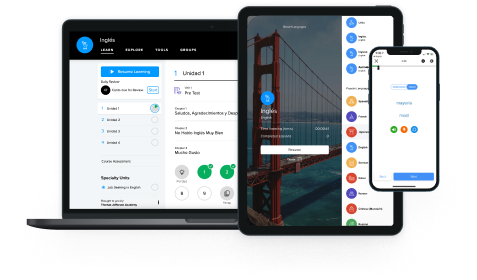Reported speech, also known as indirect discourse, is the reproduction or “repackaging” of someone else’s message. In English and in Spanish, we normally begin reported speech with a reporting verb (dijo ("he/she said")), preguntó ("he/she asked"), etc.), followed by a conjunction (que ("that")) and then the message. With that said, reported speech in Spanish has a few rules we need to keep in mind. Are you ready to be the messenger? Let’s get started!
Direct vs indirect speech
Spanish and English both have different means of communicating what someone has said. One way is called direct speech. Direct speech works the same in both languages: you use direct quotations and a punctuation mark to introduce the message. In English, we use a comma, but in Spanish, we introduce direct speech with a colon. Here is an example of direct speech:
El profesor fue claro. Nos dijo: “Hagan la tarea para mañana.”
The professor was clear. He told us, “Do your homework for tomorrow.”
Indirect speech, while still relaying a message, has a few more things to consider. In Spanish, we can indirectly report statements, questions (yes/no and content), and commands/requests. Because we use indirect speech way more than direct speech in our daily life, we need to make sure you know how to use it and how to build it to avoid confusion or mixed messages. What does indirect speech look like, you ask? Here are some examples:
Indirect statement:
La señora explicó que para abrir la puerta necesitábamos jalar, no empujar.
The lady explained that to open the door we needed to pull, not push.
Indirect command:
Mi mamá me dijo que hiciera la cama y guardara los platos.
My mom told me to make the bed and put away the dishes.
Indirect question:
Mi hermana nos preguntó si íbamos a reunirnos para su cumpleaños.
My sister asked us if we were going to get together for her birthday.
While still relaying a message, see how the reported/indirect messages have to change in both languages? Let’s get our learning going!
How to build indirect speech in Spanish?
Before we begin any type of indirect speech, we must start our clause with a verb of reporting. The following are some frequently used verbs of reporting:
decir ("to say, to tell")
preguntar ("to ask")
querer ("to want")
explicar ("to explain")
afirmar ("to assert")
añadir ("to add")
contestar ("to reply, to answer")
insistir ("to insist")
The verb of reporting can refer to the present or the past. If it refers to the present, the verb of reporting will be in the present (simple or progressive) or present perfect:
El niño dice/ha dicho que quiere su biberón.
The boy says/has said that he wants his bottle.
If it refers to the past, the most common form is the preterite:
El niño dijo que quería su biberón.
The boy said that he wanted his bottle.
The second ingredient in indirect speech is a conjunction that follows the verb of reporting. The conjunctions are normally que ("that") or si ("if").
Finally, we must adapt three additional items when building indirect speech. The three changes are: relation, time, and location. Keep reading to learn more!
Subject pronouns and possessives
When using indirect speech, we need to make sure we change and possessives to match the message that was given. This also happens in English. Here’s an example:
Direct speech:
María dijo: “(yo) Quiero mi burrito.”
María said, “I want my burrito.”
Indirect speech:
María dijo que ella quería su burrito.
María said that she wanted her burrito.
Notice how the indirect speech goes from first to third person since we are indirectly referring to what has been said.
Change in location and time
When we are using indirect speech, we must adjust our time and location references as well. This also happens in English! It should not be too difficult to pick up.
Time changes:
hoy ("today") → ese día/aquel día ("that day")
Julio says, “I arrive today.”
Julio dijo que llegaba ese día.
Julio said that he would arrive that day.
ahora ("now") → entonces ("then")
La niña insiste: “Quiero jugo ahora.”
The girl insists, “I want juice now.”
La niña insistió que quería jugo entonces.
The girl insisted that she wanted juice then.
mañana ("tomorrow") → al día siguiente ("the next day")
El estudiante añadió: “No estaré en clases mañana.”
The student added, “I will not be in classes tomorrow.”
El estudiante añadió que no estaría en clases al día siguiente.
The student added that he would not be in classes the next day.
Click the link to see some additional Spanish expressions and how they change with indirect speech!
Notice that if you're reporting in the present, you might not need to change the time reference. It’s all a matter of time relativity! For instance, llego hoy ("I arrive today"), if you're relaying this message on the same day then there is no need to change:
Dice Julio que llega hoy.
Julio says he arrives today.
Location changes:
Adverbs of place: aquí ("here") → allí, ahí ("there")
Mi papá dijo: “Estaciónate aquí.”
My dad said, “Park here.”
Mi papá quiso que me estacionara allí.
My dad wanted me to park there.
These include demonstratives, adjectives, and pronouns because they deal with distance from the speaker!
este, esta ("this") → ese, esa, aquel, aquella ("that")
estos, estas ("these") → esos, esas, aquellos, aquellas ("those")
Directionality/verbs of direction will also change!
llevar ("to take") → traer ("to bring")
ir ("to go") → venir ("to come")
And vice versa!
Ana dice: “Llevo café para todos.”
Ana says, “I’ll bring coffee for everyone.”
Ana dice que trae café para todos.
Ana says she’ll bring coffee for everyone.
For more on how to use these particular verbs in Spanish, head over to our post!
Adapting verb tenses in indirect speech
The last crucial change in building indirect speech happens to verb tenses. Just like we change time expressions above, sometimes we need to change verb tenses to ensure the message is being communicated appropriately. Here are a couple of examples:
If the reporting verb is related to the present, then there is NO NEED to change the verb tense.
El doctor dice: “No ⤷presentpuedo atenderte.”
The doctor says, “I can’t see you.”
El doctor dice que no ⤷presentpuede atenderme.
The doctor says he cannot see me.
If the reporting verb is related to the past, then you will need to change the verb tense.
El doctor dijo: “No ⤷presentpuedo atenderte.”
The doctor says, “I can’t see you.”
El doctor dijo que no ⤷imperfect podía atenderme.
The doctor says he cannot see me.
For a full list of Spanish verb tenses and their corresponding tense in indirect speech, click the link!
We will see next that these rules also apply to indirect questions, but they do not when using commands. Keep reading to find out which verb tenses you use with Spanish commands.
Indirect questions in Spanish
If you are relaying a question with indirect speech, there are a couple of different options for doing so. However, the most common verbs of reporting for questions are: preguntar ("to ask") and querer saber ("to want to know"). With regard to verb tenses, it works exactly like the indirect statements above. Let’s check questions and indirect speech, shall we?
Yes and no questions
Mi hermano preguntó: “¿Tienes chicle?”
My brother asked, “Do you have gum?”
Mi hermano preguntó si tenía chicle.
My brother asked if I had gum.
To report a yes/no answer, you can say:
Questions words
f you are reporting a question that originally had a question word (who, what, when, where, etc.), you will not require the use of que ("that") or si ("if"). Instead, you will keep the original question word in Spanish as your "bridge" between the reporting verb and indirect speech. For example:
El chico preguntó: “¿Dónde está la Rambla?”
The boy asked, “Where is the Rambla?”
El chico preguntó dónde estaba la Rambla.
The boy asked where the Rambla was.
Erica quiere saber: ¿Cuándo es la asamblea?
Erica wants to know, “When is the assembly?”
Erica quiere saber cuándo es la asamblea.
Erica wants to know when the assembly is.
In colloquial speech it is common to insert "que" between the reporting verb “preguntar" and the question word or before si for yes/no indirect questions.
Enrique me preguntó (que) por qué habías llegado tarde.
Enrique asked me why you had arrived late.
Los estudiantes preguntaron (que) si podían tener una extensión.
The students asked if they could have an extension.
For more on questions, check out: "How to build questions in Spanish?"
Indirect commands in Spanish
To use indirect speech to relay commands, the format continues being similar to indirect statements:
Introduce the indirect speech with a verb of reporting.
Follow it with the conjunction que ("that").
Finally, if the verb of reporting is in the present, present continuous, or present perfect, then the command will be in the present subjunctive. For example:
Tu papá pide que compres leche, por favor.
Your dad asks that you buy milk, please.
On the other hand, if the verb of reporting is in the preterite, imperfect, or past perfect, then the command will be in the imperfect subjunctive.
Tu papá pidió que compraras leche, por favor.
Your dad asked you to buy milk, please.
Need a refresher on these subjunctive tenses? We have you covered with these posts on the Spanish present subjunctive and the Spanish imperfect subjunctive.
To sum it up
Indirect speech is used for indirectly reporting statements, questions (yes/no and content), and commands/requests. In order to build indirect speech appropriately, we need to keep in mind the following pieces:
Start the clause with a verb of reporting, such as decir ("to say, to tell"), preguntar ("to ask"), querer ("to want"), etc.
Follow the verb of reporting with a conjunction.
que ("that") for indirect statements and commands, or
si ("if") for yes/no questions
a question word (who, what, when , where, etc.) for content questions.
Finally, we must adapt three additional items when building indirect speech:
Time changes: making sure the time expressions are appropriately adjusted to fit an indirect message.
Location changes: making sure words that imply distance from the speaker also match the indirect speech.
Verb tense changes: We change verb tenses to ensure the message is being communicated appropriately.
Statements and questions use verbs in the indicative.
Commands use verbs in the subjunctive.
While it seems like a lot of stuff to remember, these changes make sense because so many of them also happen in English. The best way to master indirect speech is to practice it, so I have created an activity for you to get you started with it. You can check it out by clicking the link!
To embark on your next language adventure, join Mango on social!

